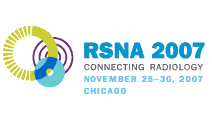
Abstract Archives of the RSNA, 2007
Shan Wang PhD, Presenter: Nothing to Disclose
Anthony M. Passalaqua MD, Abstract Co-Author: Nothing to Disclose
Mangxue Li MS, Abstract Co-Author: Nothing to Disclose
GuangLin L. Wang, Abstract Co-Author: Nothing to Disclose
We present a new method, single energy window (SEW) method, to perform scatter elimination.
Based on the total photons, Nt, and total energy, Et, acquired by a pixel on the detector plane, the number of primary photons is calculated by
Np = (Et-Ntes )/(ep-es )
where ep is the photopeak of activity and es is the mean scatter photo energy acquired by a pixel in detector plane. It is calculated by es=ΣEt(R)D(R)/ΣNs(R)D(R). The sum covers every voxel R in the object. The point source scatter parameters, Ns(R) and Et(R), are the total scatter photons and total scatter energy emitted from a point source at R and acquired by the pixel on the detector plane. D(R) is the source distribution inside the object. The point source scatter parameters are dependent on the attenuation coefficient distribution and independent of the source distribution. We introduce a model to simulate the point source emission in a uniform attenuation object with cylindrical shape. The scatter energy is calculated based on the Compton scattering equation and the angular distribution of the scatter photon is predicted by Klein-Nishina formula.
We found that the changes of the point source scatter parameters are noticeable when the source is moving along the direction perpendicular to the detector plane and almost negligible when it is moving parallel to the plane. We apply the SEW method to perform scatter elimination on a Jaszczak Phantom test. The source distribution for the planar study is predicted by the planar image. An iterative reconstruction algorithm is used for SPECT study, whose initial input is a SPECT image without scatter elimination.
The SEW method improves the image quality and quantitative accuracy compared to the triple energy window method.
We can apply the SEW method to clinical studies for scatter elimination by the photons and energy acquired from a user specified energy range.
Wang, S,
Passalaqua, A,
Li, M,
Wang, G,
Single Energy Window Analysis for Scatter Elimination. Radiological Society of North America 2007 Scientific Assembly and Annual Meeting, November 25 - November 30, 2007 ,Chicago IL.
http://archive.rsna.org/2007/5013457.html

